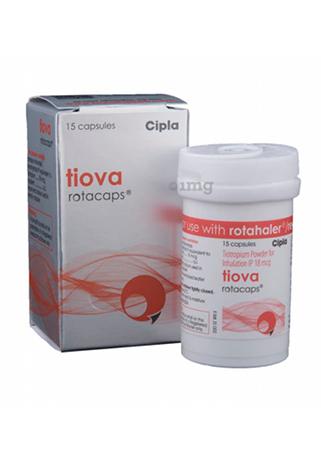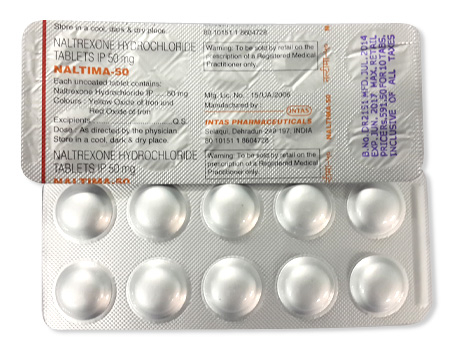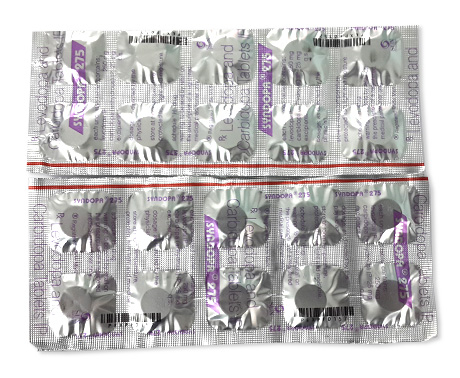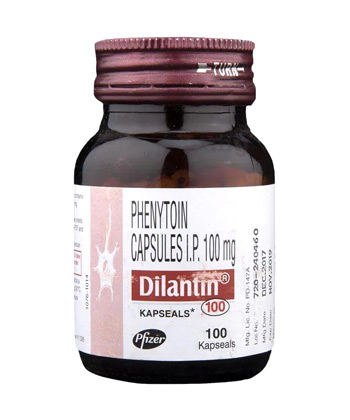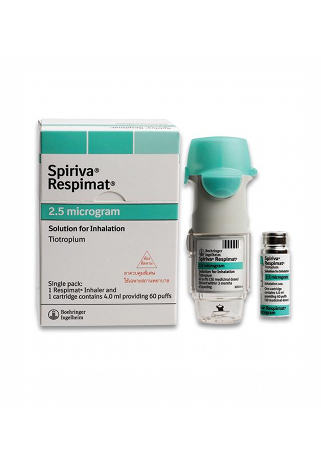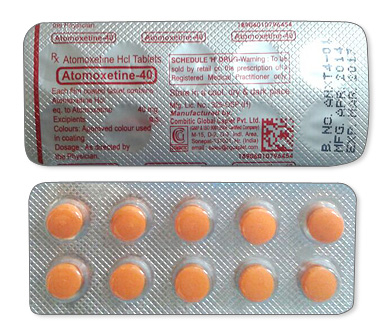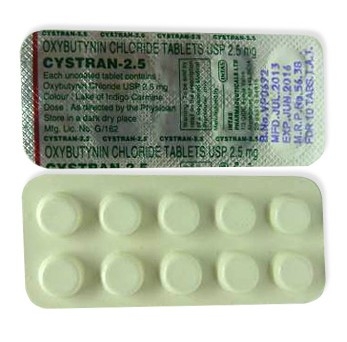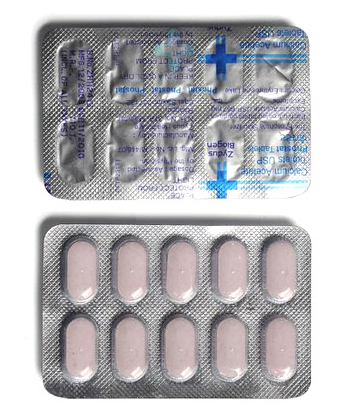Ditropan
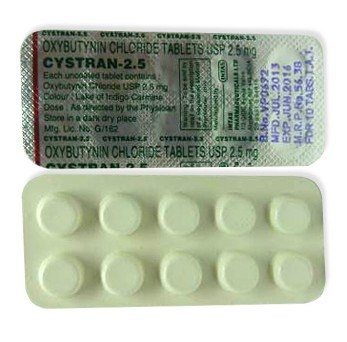
Ditropan
- In our pharmacy, you can buy Ditropan without a prescription, with delivery in 5–14 days throughout United Kingdom. Discreet and anonymous packaging.
- Ditropan treats overactive bladder symptoms like urinary urgency, frequency, and incontinence. It works by blocking muscarinic receptors, relaxing bladder smooth muscle and reducing involuntary contractions.
- Usual dosage is 5 mg 2–3 times daily for immediate-release tablets, or 5–10 mg once daily for extended-release formulations.
- Available as immediate-release tablets, extended-release tablets, or oral syrup.
- Onset occurs within 30–60 minutes for immediate-release forms.
- Duration is 6–8 hours for immediate-release and up to 24 hours for extended-release formulations.
- Avoid alcohol consumption as it may increase drowsiness, dizziness, and cognitive side effects.
- Dry mouth is the most common side effect.
- Would you like to try Ditropan without a prescription?
Basic Ditropan Information
| INN (International Nonproprietary Name) | Oxybutynin chloride |
| Brand names in United Kingdom | Ditropan (Pfizer Ltd), Generic oxybutynin |
| ATC Code | G04BD04 (Urinary antispasmodics) |
| Forms & Dosages | 5mg immediate-release tablets, 5mg/5ml syrup |
| UK Manufacturer | Pfizer Ltd (brand version) |
| UK Registration Status | EMA-approved, available on NHS prescription |
| Classification | Prescription only (Rx) |
Ditropan contains oxybutynin chloride, an anticholinergic medication primarily prescribed for bladder control problems. Under UK regulations, both the branded Ditropan and generic oxybutynin are available through NHS prescriptions. The medicine comes in 5mg immediate-release tablets typically packaged in blister packs of 28 or 56 tablets, plus a liquid formulation (5mg/5ml syrup) for precise dosing. The extended-release version sold in other countries as Ditropan XL isn't available in UK pharmacies.
Pharmacological Profile Of Ditropan
Ditropan works by blocking specific muscarinic receptors in the bladder muscle, reducing involuntary contractions that cause urgent urination and incontinence. This action occurs because oxybutynin competes with acetylcholine at nerve endings, effectively relaxing the detrusor muscle that controls urination.
After taking immediate-release tablets, absorption begins quickly with effects noticeable within about one hour. The liver processes the medication through the CYP3A4 enzyme pathway before the kidneys eliminate it from the body. This metabolic route explains several interaction concerns that require consideration before prescribing.
Key interactions affecting Ditropan's safety and effectiveness include:
- Avoidance with strong CYP3A4 inhibitors like ketoconazole which increase drug levels
- Enhanced anticholinergic effects when combined with tricyclic antidepressants or antipsychotics
- Potentiated drowsiness when consumed with alcohol or other nervous system depressants
Monitoring becomes crucial with co-administration of these medications due to potential overstimulation of anticholinergic pathways and altered pharmacokinetics of oxybutynin.
Approved And Off Label Uses
European Medicines Agency authorises Ditropan for two primary conditions. The most common prescribed use is management of overactive bladder symptoms, including troublesome urinary frequency, sudden urgency and episodes of urge incontinence. This approval applies to adults experiencing symptoms from idiopathic causes. Additionally, it's prescribed for neurogenic detrusor overactivity in children aged six years or older, particularly those with neurological conditions such as spina bifida that impact bladder nerve signalling.
Beyond formal approvals, UK specialists sometimes prescribe oxybutynin off-label for bedwetting cases unresponsive to standard treatments and for post-surgical urgency following prostate procedures. Such uses remain at the physician's discretion following careful risk assessment.
Special precautions apply to specific patient populations. Pregnancy usage is categorised as risk category C, indicating limited human safety data requires cautious consideration. Elderly patients often commence treatment at reduced dosages due to increased vulnerability to cognitive impairment from anticholinergic effects. For children prescribed Ditropan syrup, regular monitoring includes growth tracking alongside symptom management.
Standard Dosage And Administration
Adults managing overactive bladder typically start with one 5mg immediate-release tablet taken 2-3 times daily. The maximum daily dose shouldn't exceed 20mg distributed across the day. For children aged six and above requiring treatment for neurogenic bladder dysfunction, the regimen might use either the syrup form or tablets starting at 5mg once daily with gradual increases at weekly intervals as needed, up to a ceiling of 20mg daily.
Administration methods differ between formulations. Patients can take immediate-release tablets with or without food according to personal preference. While the UK doesn't market extended-release versions, patients should remember to swallow any such medications whole rather than crushing or chewing if they've been prescribed by a specialist.
Treatment duration extends long-term for chronic overactive bladder cases. Both effectiveness and side effects should undergo professional review every six months according to NHS guidelines. Regular assessments help determine if continuing the medication provides net benefit.
Special Adjustments And Handling
Special dosing considerations apply to patients with reduced kidney or liver function. Both groups typically start with half the standard initial dose under medical supervision. Complete avoidance becomes necessary for those classified as having severe hepatic or renal impairment where drug processing capabilities are fundamentally compromised. Elderly patients also require careful dosing approaches, often beginning treatment with 2.5mg doses twice daily.
When a scheduled dose gets forgotten, skip it if nearly time for the next scheduled administration. Taking double doses to compensate risks overdose situations. Significant overdosage manifests through cardiac rhythm disturbances, confusion, severe delirium or dangerous temperature elevation requiring urgent hospital evaluation.
Correct storage preserves medication stability. Maintain Ditropan below 25°C in its protective packaging away from humidity sources like bathrooms. Oral syrup should be discarded three months after first opening to prevent microbial contamination or degradation. Always retain medicines safely locked away from children's reach as with all prescription drugs.
Contraindications and Precautions for Ditropan Use
Ditropan should never be used by patients with existing urinary retention or gastric retention issues as it may worsen these conditions. Those with uncontrolled narrow-angle glaucoma face serious risks since the medication can further increase eye pressure. Known allergic reactions to oxybutynin or any tablet components also represent an absolute contraindication.
Special caution applies to high-risk populations. Individuals with autonomic neuropathy might experience intensified constipation due to reduced gut motility. Myasthenia gravis patients could see aggravated muscle weakness from the drug's anticholinergic effects. Inflammatory bowel conditions like ulcerative colitis carry heightened risks of toxic megacolon.
When taking other medications, specific precautions are necessary. Blood pressure monitoring becomes crucial when combining Ditropan with antihypertensives due to possible compensatory tachycardia. Central nervous system depressants may intensify drowsiness, requiring dosage adjustments. Regular bowel function checks help prevent severe constipation in vulnerable patients. Pharmacy consultations provide personalised risk assessment regarding these contraindications.
Adverse Effects Spectrum of Ditropan
Dry mouth is the most frequently reported side effect of Ditropan, affecting over half of long-term users, followed by constipation (approximately 30%) and blurred vision caused by pupil dilation. Daytime drowsiness occurs notably during initial treatment weeks. Moderate effects include urinary hesitation, experienced when trying to initiate urination, alongside occasional heart palpitations and increased susceptibility to overheating.
Serious but rare complications require immediate action. Hallucinations or confusion indicate central nervous system effects, particularly in elderly users. Heart rhythm abnormalities from QT prolongation demand urgent medical evaluation. Sudden facial swelling or breathing difficulties signal angioedema. Managing discomfort involves practical solutions: sugar-free gum alleviates dry mouth, increased fibre intake combats constipation, and rigorous hydration prevents heat-related illnesses. Discontinuing Ditropan becomes necessary for cardiovascular symptoms or cognitive disturbances, with alternatives considered during pharmacy reviews.
Patient Reports and Medication Adherence Challenges
Approximately 60% of users report significant reductions in incontinence episodes according to Drugs.com data. Despite this effectiveness, nearly half discontinue treatment prematurely due to tolerability issues. The most common complaint involves persistent dry mouth affecting quality of life. Cognitive effects trouble elderly populations more frequently.
Adherence strategies can mitigate unpleasant reactions. Taking Ditropan tablets at bedtime minimises daytime drowsiness. Switching formulations like transdermal patches reduces gastrointestinal complaints when available. Practical lifestyle adjustments include carrying water for dry mouth and setting medication reminders. User testimonials reflect experiences: "Urgency improved drastically but constant dry throat persists" (Liverpool patient), while migraine sufferers note "Less toilet trips during work hours despite worsened constipation". Guidance emphasises gradual dosage escalation rather than abrupt cessation when side effects occur.
OAB Medication Comparisons in the UK Healthcare Context
| Medication | Monthly NHS Cost | Effectiveness Profile | Side Effect Differences |
|---|---|---|---|
| Tolterodine | £15-£20 | Comparable reduction in urinary frequency | Lower rates of dry mouth |
| Solifenacin | £20-£25 | Superior for urgency symptoms | Reduced sedation impact |
| Mirabegron | £30-£35 | Different mechanism of action | Potential blood pressure elevation |
Clinical guidance prioritises solifenacin as initial therapy for patients under 65 due to improved tolerability. Ditropan remains strategically valuable for budget-limited scenarios according to NICE cost-effectiveness assessments. Mirabegron offers non-anticholinergic action suitable for cognitively vulnerable groups. Marked variations exist between NHS regions regarding formulary preferences. Transparent discussions with GPs about individual priorities determine optimal selection between symptom control, cost considerations and lifestyle compatibility through medication reviews.
UK Market Access Insights
Finding oxybutynin in the UK remains straightforward through major pharmacy chains like Boots and LloydsPharmacy. Generic versions dominate due to NHS cost-saving initiatives, with brand-name Ditropan rarely available since 2022. Immediate-release tablets cost approximately £9-12 for 28 tabs (5mg strength), though NHS patients typically pay standard prescription charges. Supply chains show good stability post-COVID, but pharmacists note occasional regional stock variation for dispensing. Packaging follows UK standards with calendar blister packs—no loose bottle distribution allowed. Emerging alternatives include ongoing trials for Oxybutynin OTX transdermal patches expected by 2025. When searching options, common queries include "buy cheap oxybutynin UK" and "NHS prescription bladder medication availability".
Clinical Evidence & Developments
Current evidence reaffirms oxybutynin's effectiveness for overactive bladder, with a 2023 Cochrane review of 3,100 patients showing 28% symptom reduction versus 19% in placebo groups. Since its 2010 patent expiry, research focuses on improved formulations like transdermal gels (currently in Otter-Learn TPL-2024 trials) to reduce dry mouth side effects. Clinical guidelines now position it as second-line therapy after newer agents like solifenacin due to its anticholinergic burden. The European Medicines Agency may expand approval for paediatric syrup use in neurogenic bladder cases by late 2025. Key developments involve combination therapies with beta-3 agonists like mirabegron to enhance efficacy. Researchers remain focused on long-term cognitive safety data.
Guidelines for Safe & Effective Use
Proper oxybutynin management ensures maximum benefit with minimal risk. Consistently take doses at fixed times using phone reminders to maintain steady medication levels. Swallow extended-release tablets whole with water—never crush or split them. Food can reduce nausea with immediate-release versions, but avoid high-fat meals which delay extended-release absorption. Significant precautions include: - Total avoidance of grapefruit juice (increases toxicity risk) - Alcohol limitation to prevent intensified drowsiness - Humidity-controlled storage away from bathrooms Practical solutions include: Using pill organisers to prevent double-dosing, increasing water/fibre intake to counter constipation, and monitoring for cognitive changes. Immediately report hallucinations, severe dizziness or chest pain. Always review the Patient Information Leaflet for specific guidance on missed doses.

